Experience your own Nordic saga with this 7 day itinerary for Iceland, a truly epic self-drive road trip adventure that takes in some of the most spectacular scenery across the island’s south and south-west.
It’s impossible not to be captivated by Iceland. A mystical land of icy glaciers and fiery volcanoes where Vikings once roamed; a place where the sun shines all night in summer, and strange lights dance across the night sky in winter.
A land of extremes, Iceland is blessed with a rugged, otherworldly landscape of vast lava fields, black sand beaches, steaming geothermal pools, and jagged cliffs that drop into the freezing North Atlantic.
Despite its isolation, Iceland is easy to explore. Reykjavik, the capital, is compact and full of character, with trendy cafés, galleries, some decent bars and restaurants, and a pretty cool music scene.
Beyond Reykjavik, nature takes over. Thundering waterfalls, erupting geysers and dramatic coastlines dominate. The wildlife is equally impressive, from puffins and Arctic foxes to the whales that patrol the surrounding waters.
The weather is unpredictable, but that only adds to the experience. One moment you’re in bright sunshine, the next, in the midst of a sudden storm.
Whether you’re exploring ice caves, hiking through lava fields, snowmobiling on a volcano, soaking in a remote hot spring, or chasing the northern lights, an Iceland road trip delivers something different every time. It’s wild, beautiful, and never boring.
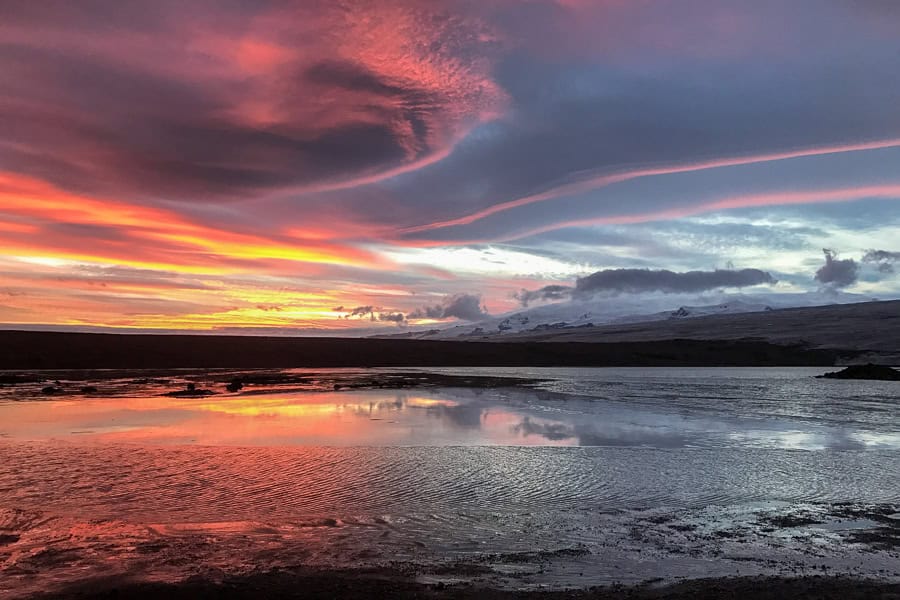
7 Day Itinerary for Iceland
Start & Finish: Reykjavik
Distance: appx. 1,680km (1,045 miles)
How long do I need? Allow at least a week for this action-packed Iceland road trip adventure, exploring the best of Reykjavik, the Snaefellsnes Peninsula, the Golden Circle and the southern stretch of Iceland’s famous Ring Road.
Overnight stops: 1 night in Reykjavik, 1 night in Grundarfjörður (Kirkjufell), 1 night in Laugarvatn, 3 nights in Skógar and 1 night in Keflavik.
What’s in this post?
What’s the Route?
Planning an Iceland Road Trip
– Getting to Iceland
– Best Time to Visit Iceland
– Planning a Trip to Iceland in Winter
– Where to Stay in Iceland
– Driving in Iceland
– Driving in Iceland in Winter
– Iceland Car Hire
– Is Iceland Expensive?
Our 7 Day Itinerary for Iceland
– Day 1: Get to Know Reykjavik
– Day 2: Explore the Snaefellsnes Peninsula
– Day 3: Driving the Golden Circle Route
– Day 4: Explore the Volcanic Landscape of Southern Iceland
– Day 5: More Highlights of the Southern Ring Road
– Day 6: Jökulsárlón Glacier Lagoon and Ice Cave Adventures
– Day 7: Slow Drive Back to Reykjavík
This post contains affiliate links. If you choose to buy through these links we may earn a small commission at no extra cost to you, which helps us to keep Two for the World running. Many thanks for your support!
What’s the Route?
We focused our Iceland road trip itinerary on the south and south-west of the country, packing in some of the island’s most dramatic landscapes in just a week.
Starting in Reykjavik, you’ll spend a day exploring the capital, checking out the colourful streets, Harpa Concert Hall, and the views from Hallgrímskirkja, before hitting the road.
Day two takes you to the Snaefellsnes Peninsula, often called ‘Iceland in miniature’ for its mix of mountains, lava fields and coastal cliffs. From Kirkjufell to black sand beaches, it’s a taster of what’s to come.
Next, you’ll tackle the Golden Circle, home to the geysers of Strokkur and Geysir, the mighty Gullfoss waterfall and Thingvellir National Park, before embarking on the breathtaking southern Ring Road with its glaciers, waterfalls and black sand beaches.
You’ll have three nights to explore the southern Ring Road, visiting Dyrhólaey promontory, Reynisfjara beach, and the icebergs of Jökulsárlón Glacier Lagoon. This is also an opportunity to get adventurous on a snowmobile tour of Mýrdalsjökull Glacier and an ice cave tour at Vatnajökull Glacier.
This 7 day itinerary for Iceland finishes with a slow drive back to Reykjavik for a well-deserved soak in the nearby Blue Lagoon. There, you can reflect on a truly epic road trip before catching your flight home.
It’s a whirlwind trip, but we assure you, every stop is a highlight.
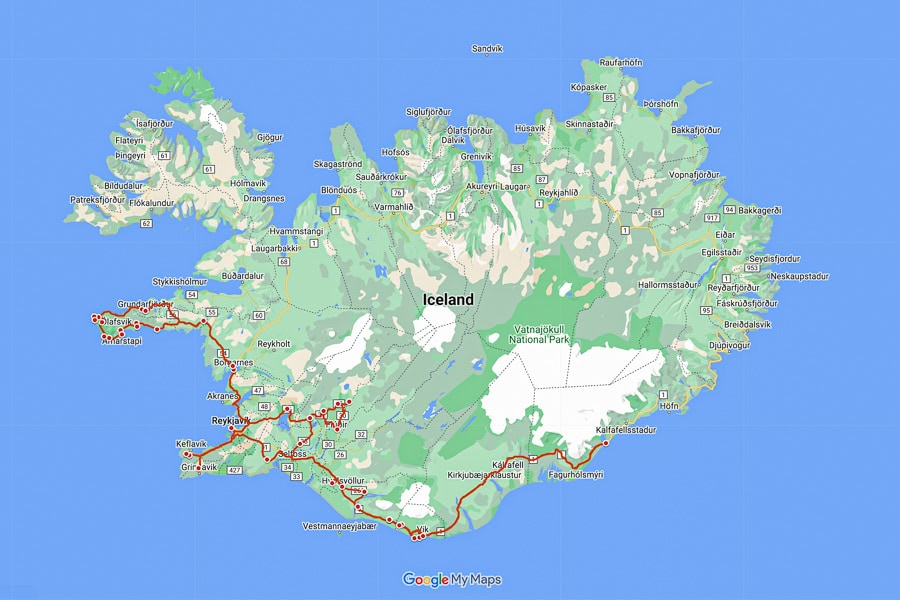
Time of Year Makes a Big Difference
We’ll be honest, this is a fairly ambitious itinerary that covers a lot of ground in just a week.
While we were able to do this itinerary in winter, daylight hours and weather are a huge factor if you’re planning to road trip Iceland.
See the section on the best time to visit Iceland for more information on seasonal considerations.
Planning an Iceland Road Trip
Getting to Iceland
Getting to Iceland is straightforward, with Keflavik International Airport (KEF) serving as the main gateway. The airport is about 45 minutes from Reykjavik, with buses or rental cars being the most convenient ways to reach the city.
Direct flights run from major cities in Europe and North America, with Easyjet and a host of other airlines operating frequent flights to Reykjavik.
If you want to take your own vehicle, there are car ferries from Denmark that travel to Iceland via the Faroe Islands (a stop-over in the Faroes is required). This approach is definitely on our list for a future visit.
Best Time to Visit Iceland
With midnight sun in summer and long nights in winter, time of year will have a huge impact on your trip planning and experience. The best time of year to visit Iceland really depends on what you want to see and do.
Summer (June to August) offers almost 24-hour daylight, mild temperatures and access to the Highlands, but also more tourists and higher prices. It’s a great season for road trips, hiking, whale watching and seeing puffins (a big future trip planning consideration for us bird nerds as we didn’t get to see puffins while we were there).
Spring and autumn (April to May and September to October) strike a great balance. You get fewer crowds, slightly lower prices, and a mix of summer and winter scenery. Both seasons have decent daylight for exploring and clearer roads. If you’re very lucky, you might even glimpse some start or end-of-season northern lights.
Winter in Iceland (November to March) is a very different experience, with short daylight hours and unpredictable weather. This is the season for aurora spotting though (mid-September to early April), and for exploring ice caves, which are only accessible in winter. Blanketed in snow and ice, the landscapes feel even more otherworldly.
We opted to visit Iceland in early winter as we wanted to see the island in its icy splendour and we were hoping to glimpse the northern lights. We also wanted to avoid the high season crowds and costs.
Whenever you visit though, be prepared for unpredictable weather – sun, rain and snow can all happen in a single day. Packing layers is essential.
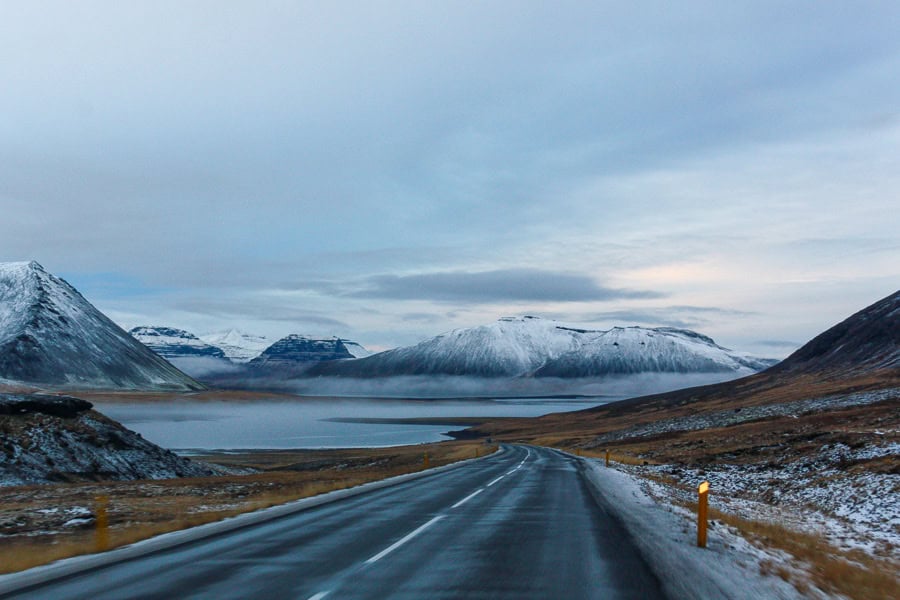
Planning a Trip to Iceland in Winter
Winter in Iceland means short days and potentially challenging driving conditions. There’s a chance the weather could turn or set in at any time. With just seven nights on the island, and around six hours of light each day, a realistic and flexible plan is essential.
That said, in our experience, early winter is a great time to visit Iceland. While we had a fairly good plan to start with, we did learn a few lessons along the way:
- It’s important for your itinerary to be realistic for the time of year. We underestimated driving times and overestimated the hours of light we had, meaning that we had to make a few adjustments to our trip while on the road.
- When planning a trip to Iceland, be mindful that speed limits are fairly low, but conditions like fog, snow or rain will often see you driving even slower, which also impacts anticipated drive times.
- With short daylight hours and long drives, we realised we were sometimes driving past what we knew were very likely spectacular vistas, in the dark. Our suggestion is to be aware of what you might be missing, and adjust your plans if it’s a place you really want to see.
- Finally, bear in mind that visiting Iceland in winter means many places will have limited visiting hours, and some cafes, restaurants, shops and accommodations may be closed. It’s always good to call ahead just to be sure.
Where to Stay in Iceland
Accommodation in Iceland ranges from budget-friendly to high-end but one thing is consistent, beds fill up fast. Booking in advance is essential, especially in peak season.
Reykjavik has the widest selection of stays, from modern hotels to quirky guesthouses and hostels. Outside the capital, accommodation is more limited, often consisting of small hotels, family-run guesthouses, and farm stays. These can be basic but are usually comfortable, and sometimes come with absolutely stunning surroundings.
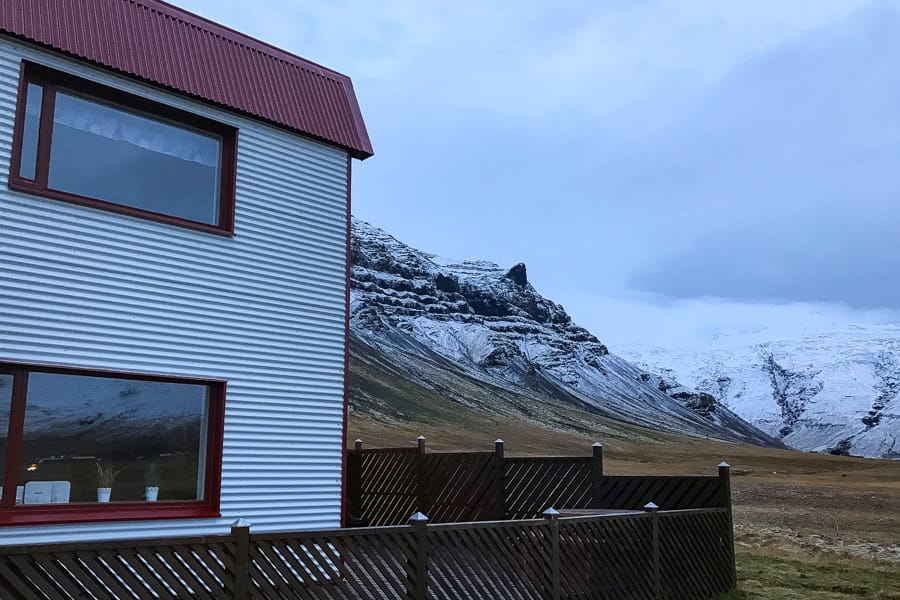
Budget travellers planning a trip to Iceland can save money by opting for a shared bathroom, however, hostels and campsites are probably the best options if you’re trying to economise.
Camping is also popular in summer. There are designated sites across the country, but wild camping is largely restricted. Campervans are another popular alternative, offering great flexibility, although Iceland’s weather means they’re best for the warmer months.
Wherever you stay, expect high prices. Accommodation in Iceland isn’t cheap, but with the right planning, you should be able to find a place that suits your budget.
We always use Booking.com to find accommodation for our road trips, and you’ll find links to places we’ve stayed and other popular, highly rated accommodation options later in this post.
Driving in Iceland
Driving in Iceland isn’t difficult if you’re prepared. Check road conditions daily, watch out for sheep, and be ready for sudden weather changes.
If you want freedom and flexibility, hiring a car is absolutely worth it. Just take it slow, respect the conditions, and enjoy the open road – there’s nowhere else quite like it.
Iceland’s main roads, including the Ring Road, are well-maintained and open year-round, but conditions can change fast.
If you’re sticking to paved roads, a standard car is fine. But if you plan to explore the Highlands (Iceland’s rugged interior) or take on rougher F-roads, a 4×4 is essential. These roads are unpaved, remote, and can sometimes include river crossings. They’re also only open in summer.
Petrol stations can be few and far between in remote areas, so it’s best to fill up when you can. Speed limits are low, and off-road driving is illegal – straying from marked roads can seriously damage the landscape.
Also, always keep a firm hold of your car door when you open it – wind gusts can be pretty powerful.
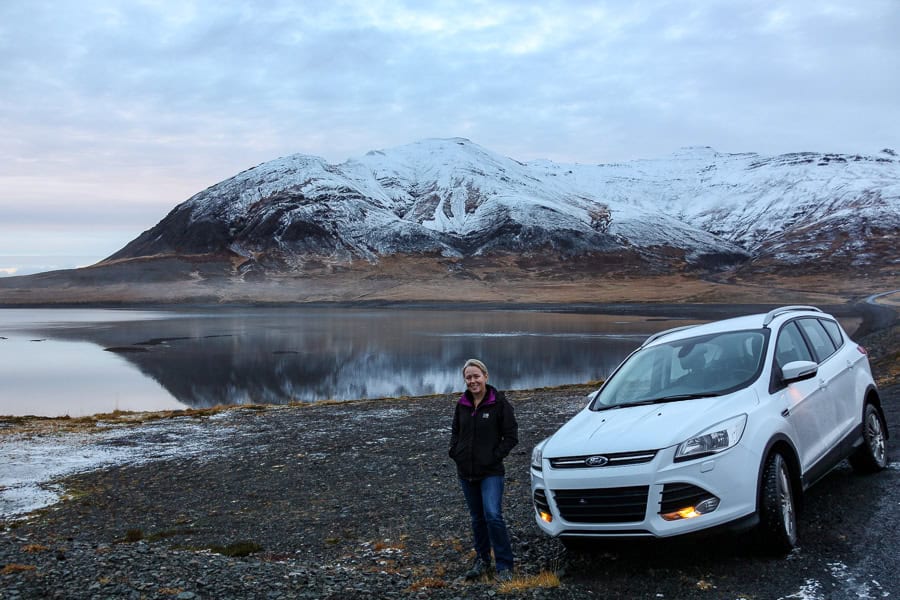
Driving in Iceland in Winter
Driving in Iceland in winter is not for the unprepared. Weather and road conditions are renowned for being changeable and challenging, with ice, snow and strong winds making driving conditions unpredictable.
The Highlands are completely off-limits in winter and F-roads are all closed. Even in summer, these require a 4×4, but in winter, they’re buried under deep snow and impassable.
Even parts of the Ring Road can shut down temporarily during winter, particularly in the north and east, where snowfall is heavier.
The stretch between Vík and Jökulsárlón is notorious for strong winds, which can create dangerous driving conditions. The Snaefellsnes Peninsula also sees frequent closures, especially around its exposed coastal roads and mountain passes.
That said, on the routes we took in the south in early winter, driving conditions were for the most part very good. Just about all the roads we travelled were clear of ice and snow. The only exception was the Snaefellsnes Peninsula, where we did have a light cover of snow on the roads and frequent bouts of fog that made for slow going and meant we weren’t able to see as much as we’d planned.
It’s vital to plan ahead, be aware of weather and what’s coming, heed warnings, and know what to do if you run into any issues.
For current travel conditions and information about staying safe as you travel around Iceland, head to the Safetravel website, which is run by the Icelandic Association for Search and Rescue.
The website also has a link to the Safetravel app, which provides up-to-date alerts on road conditions and safety information to help you be as prepared as you can be as you travel around. The app can also send GPS location data to 112 emergency services if help is needed.
Having limited winter driving experience ourselves and with safety top of mind, we opted for an all-wheel drive vehicle equipped with winter tyres, which proved to be more than suitable for our own Iceland road trip.
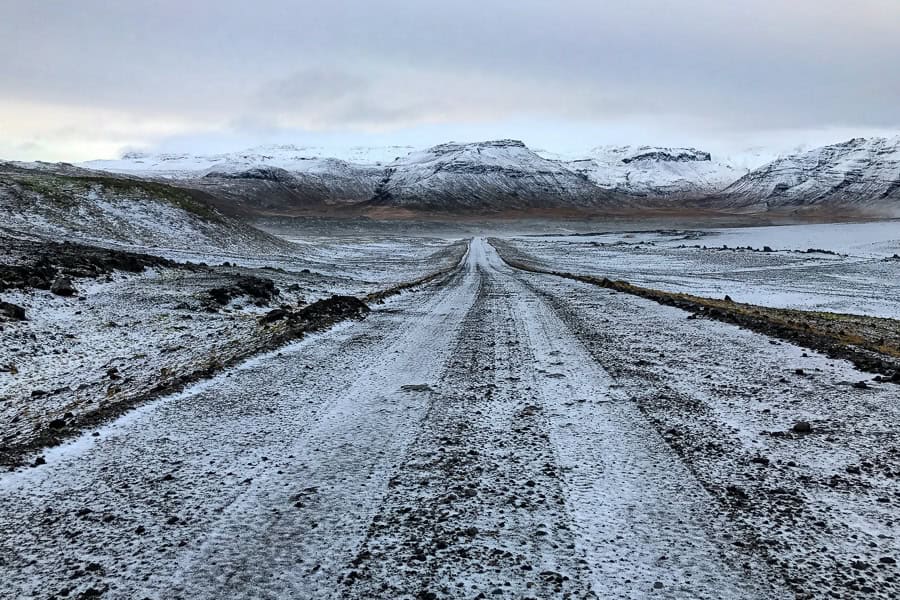
Winter in Iceland can be Truly Magical
Despite all our warnings, we don’t want to put you off visiting Iceland in winter. If you’re prepared and flexible with your plans, a winter visit can be extremely rewarding.
The landscapes are breathtaking, frozen waterfalls are even more dramatic, ice caves can be explored and, if you’re lucky, you might have the northern lights all to yourself.
Just take it slow, respect the conditions, and always have a backup plan.
Iceland Route Planner
We used Google Maps offline maps for our Iceland road trip; it worked perfectly for navigating around the major roads and sights.
Getting online using an international eSIM like Airalo can also make navigating much easier. Having access to mobile data will let you see traffic updates in real-time, and allow you to change plans on the go in response to any issues relating to traffic, weather or road conditions.
Iceland Car Hire
While researching car hire in Iceland, we came across a few horror stories of sudden winds tearing off car doors, volcanic sand storms blasting car paint, and a few stories of overzealous charging for vehicle damage.
Sifting through these stories and trying to discern myth from reality can be an ominous task that may lead you to think twice about hiring a vehicle in Iceland.
Mindful of this, and the fact we’d be driving in Iceland in winter, we opted to hire a car from Thrifty and took out additional insurance cover to protect us against any claim for damages. While this was a more expensive option, the peace of mind was worth it.
In the end, we had no issues whatsoever with our car rental and were happy with the service provided by Thrifty at Keflavik Airport.
We’ve always found the best deals, including for Thrifty and other major hire car providers, at DiscoverCars and they’re our go-to car hire provider these days.
Booking in advance will get you the best rates and choice of vehicle. DiscoverCars also offers free cancellation so if your plans change you can easily amend your booking.
Is Iceland Expensive?
We’re not going to sugarcoat it, visiting Iceland can be extremely expensive. Accommodation, petrol, tours, restaurants and booze can be very pricey. Budget-conscious travellers will need to plan well to economise where they can.
The good news however, is that Iceland’s biggest attractions – its landscapes – are free. Waterfalls, glaciers and black sand beaches don’t cost a thing to visit.
If you plan ahead, book accommodation well in advance so you have more options, drive yourself, and mix in budget-friendly options like self-catering or camping, you can still experience Iceland on a budget without laying siege to your bank account.
You can also save on accommodation by visiting Iceland in shoulder or winter seasons, but it’s still by no means cheap.
Our 7 Day Itinerary for Iceland
Day 1: Get to Know Reykjavik
Highlights: Reykjavik Walking or Food Tour | Harpa Concert Hall | Cultural Institutions | Hallgrímskirkja | Sun Voyager Sculpture
Total driving distance: appx. 50km (30 miles)
Total driving time: appx. 40 mins
Overnight: Reykjavik
You could easily while away a couple of days in Iceland’s capital, Reykjavik. This pretty, compact and cosmopolitan outpost has a range of quirky museums and historic buildings, some pretty cool street art, and plenty of eating, drinking and entertainment options.
Try to arrive as early as you can to allow time to pick up your hire car, drive to the city, and check in to your accommodation.
Reykjavik Walking Tour
As you might know if you’ve read other posts of ours, we’re big fans of city walking tours, and with just a day in Reykjavik on this Iceland itinerary, we think it’s the best way to get acquainted with the city.
The popular Reykjavik Sightseeing Walking Tour provides a great introduction to Iceland, covering history, mythology and local culture. Over the course of two hours, you’ll visit some of Reykjavik’s key landmarks like Harpa Concert Hall, Reykjavik Harbour, Hallgrímskirkja, Reykjavik Pond and the Parliament building.
This family friendly tour runs three times daily, and has secure booking and free cancellation. There are also private tour options available for an additional cost.
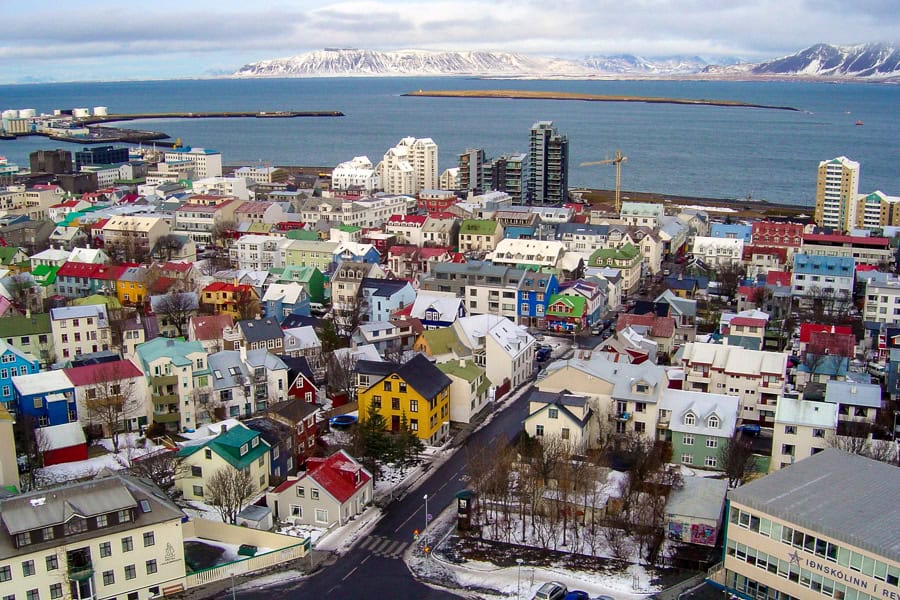
If you want a walking tour that’s more focused on local food, check out the Reykjavik Guided Foodie Walking Tour.
It’s another extremely popular tour with excellent reviews that runs a few times daily, providing a great way to see downtown Reykjavik while filling up on Icelandic fare and learning about the country’s culinary heritage.
Visit a Museum or Two
Reykjavik may be a small city, but it has a rich history and a thriving arts scene. If you have time after your walking tour and want to dive deeper into Icelandic culture, some of the best options are:
- Settlement Exhibition: This museum is built around the ruins of a Viking longhouse dating back to Reykjavik’s first settlers. Digital displays bring the past to life, showing how early Icelanders lived.
- Saga Museum: The Saga Museum recreates some of Iceland’s key history milestones with lifelike wax figures. From Viking battles to medieval legends, it’s a gritty, immersive experience.
- National Museum of Iceland: This museum offers a comprehensive look at Iceland’s history, from Viking settlement to modern independence. With over 2,000 artefacts, including medieval weapons and religious relics, it paints a vivid picture of the past.
- Reykjavik Art Museum: Spanning three locations, this museum showcases Icelandic art from traditional landscapes to contemporary installations.
If you enjoy offbeat, you’ll also find a couple of quirky offerings in Reykjavik:
- Icelandic Phallological Musuem: Once a personal collection, this unusual museum of all things phallic has grown (pun intended) into something of a phenomenon, the only one of its kind in the world.
- Icelandic Punk Museum: Located in a former public toilet block, this small museum pays homage to Icelandic punk and new wave, a scene that gave rise to world-renowned artists like Björk and Sigur Rós.
Visit Reykjavik’s Most Famous Church and Hotdog Stand
As the day winds down, head to lava-inspired Hallgrímskirkja, the Lutheran cathedral that dominates the city skyline and the city’s most famous landmark. Take the lift to the top for sweeping views over the colourful rooftops (check opening times before you go).
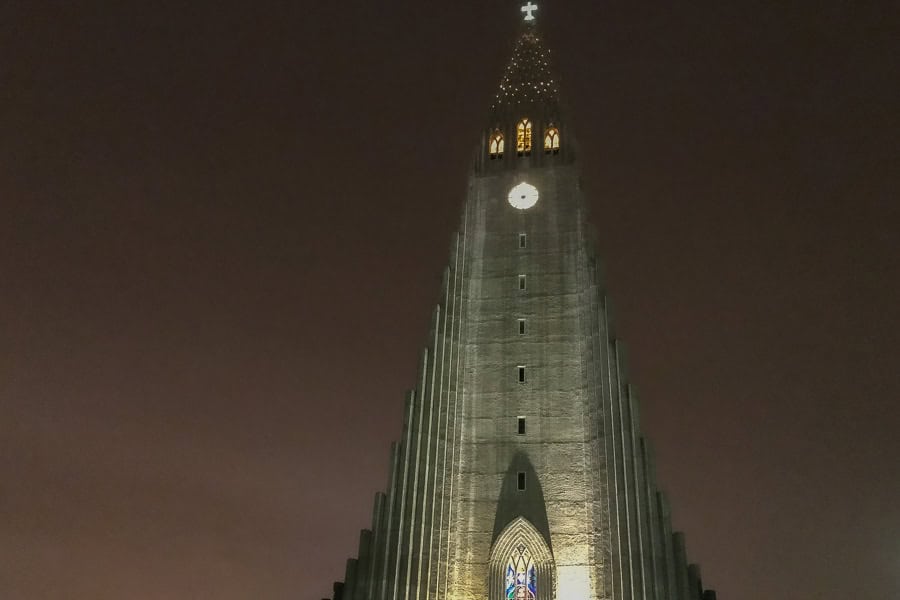
If the weather is behaving, we’d suggest making your last stop Sun Voyager, a sleek steel sculpture on the waterfront that symbolises Icelandic exploration. It’s a great spot for sunset.
While you’re wandering, follow in the footsteps of Bill Clinton and Charlie Sheen and head to the famous Bæjarins Beztu hot dog stand to devour a couple of its innocuous-looking lamb, beef and pork hot dogs with remoulade and crunchy onions. There’s nothing pretty about these dogs, but they are seriously tasty.
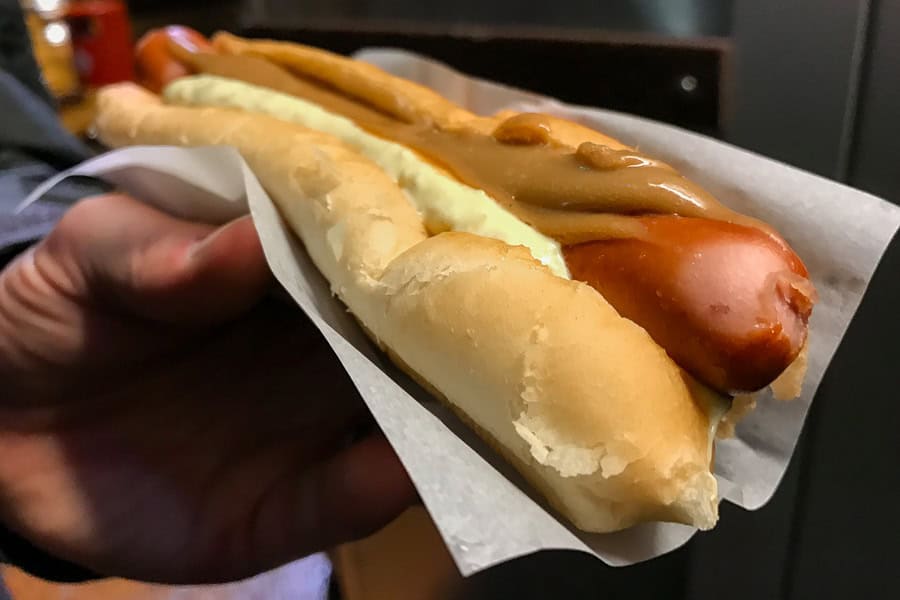
Finish up with a local beer or mulled wine in one of the city’s cozy bars. We ended up having a couple of tasty dark beers at Íslenski Barinn, but we’ve also read good things about Skúli Craft Bar and Kaldi Bar.
Where to Stay in Reykjavik
Reykjavik has a decent range of accommodation, from boutique hotels to budget-friendly hostels, guesthouses and apartments. Expect Scandinavian design, cozy spaces and, often, a fairly steep price tag.
Accommodation books up quickly, especially in summer, so it’s best to plan and book ahead. The following options get consistently good reviews:
- Good value: Guesthouse Pavi – clean, cozy rooms | communal kitchen and dining area | 15 min walk to centre | free street parking
- Mid-range: Eyja Guldsmeden Hotel– compact comfy rooms | great breakfast (paid) | friendly staff | 15 min walk to centre | on-site restaurant | street parking
- Indulge: Tower Suites Reykjavik – penthouse suite with views | modern and comfortable | 15 min walk to centre | free on-street parking | tasty breakfast.
Day 2: Explore the Snaefellsnes Peninsula
Highlights: Arnarstapi Cliffs | Snaefellsjökull National Park | Kirkjufell
Total driving distance: appx. 330km (200 miles)
Total driving time: appx. 6 hours
Overnight: Grundarfjörður (or around Kirkjufell)
The Snaefellsnes peninsula is often called ‘Iceland in Miniature’ because it has a bit of everything amazing that Iceland has to offer – volcanic craters, lava fields, black sand beaches, dramatic cliffs, waterfalls, even a glacier-capped volcano.
Snaefellsnes Peninsula in a Day
It’s just about possible to see all the main sites on the Snaefellsnes Peninsula in a single day, especially in summer, but it’s a very busy day indeed.
If you have the luxury of more time you may want to consider putting aside a couple of days to do the peninsula justice.
In winter, with less daylight, you won’t have time to do the whole peninsula, so you’ll need to adjust this itinerary to allow for the hours of light that you have. We focused on the eastern side of the peninsula so we could ensure a visit to Kirkjufell.
It’s a big day, so hit the road as early as you can. Just over an hour north of Reykjavik, take the opportunity to pick up lunch for later (and maybe more coffee and a snúðar) at Geirabakarí Kaffihús in Borgarnes, which you can enjoy with a view further up the road at the atmospheric Borg á Mýrum historic estate.

You’ll be starting to get a sense of what the day has in store by the time you spot the stark outline of Eldborg Crater rising in the distance, before the dramatic basalt columns of the Gerðuberg Cliff come into view further along the road. Be sure to stop to admire the cliffs, even if you don’t have time for the 3-hour hike to the crater.
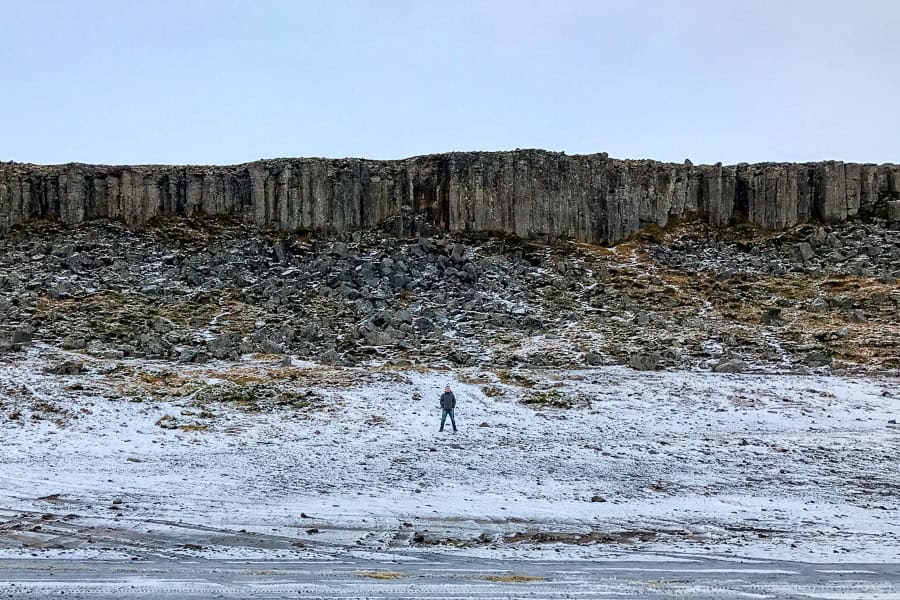
From here, take on the peninsula in a clockwise direction, first heading for Ytri Tunga Beach to see if you can spot any members of its resident seal colony. Next, stop to admire beautiful Bjarnafoss waterfall, just 15 minutes down the road, before heading on to nearby Búðakirkja, a striking black church set against an eerie backdrop of lava fields.
After another 15-minute hop along the road, take the turnoff to Rauðfeldsgjá Gorge, where you can take a short, steep walk up to enter the narrow canyon and see its waterfalls.
Further along, you’ll come to a turnoff for rough and ready mountain Road F570, where 4WD vehicles can head off to explore Sönghellir Cave, famous for its eerie echoes and great views. If you’re feeling particularly adventurous, continue for a further 5km to the Snaefellsjökull Glacier viewpoint.
Jules Verne fans might well recognise the glacier-capped Snaefellsjökull volcano from the novel, A Journey to the Centre of the Earth. For those with enough time (5 to 8 hours), and appropriate levels of enthusiasm and fitness, there are hiking tours to the glacier summit.
If you’ve just got a day for the peninsula, you’ll probably have to skip the bumpy joys of mountain Road F570 and head straight to the small fishing village of Arnarstapi. It’s an area known for dramatic coastal cliffs and basalt rock formations, so take the scenic walking trail that connects the harbour to the Gatklettur sea arch and enjoy the views.
From Arnarstapi, Road 574 heads into Snaefellsjökull National Park, where it winds a dramatic loop around one of the most scenic areas of Iceland.
There’s far too much to cover here in any detail, however the highlights include the towering basalt sea stacks of Lóndrangar, Vatnshellir Cave with its 8,000-year-old lava tube, shipwreck strewn Djúpalónssandur Beach, Saxhóll Crater, and if you have a 4WD, the golden sands of Skarðsvík Beach, and remote, windswept lighthouses of Öndverðarnes and Svortuloft.
Time your drive to exit the national park and pass through Hellissandur, famous for its street art, before arriving around sunset at the striking mountain and waterfalls of Kirkjufell, near the northern peninsula town of Grundarfjörður. This is possibly the most photographed spot in Iceland, so you’ll want plenty of time here to enjoy the view and take a gazillion pics.
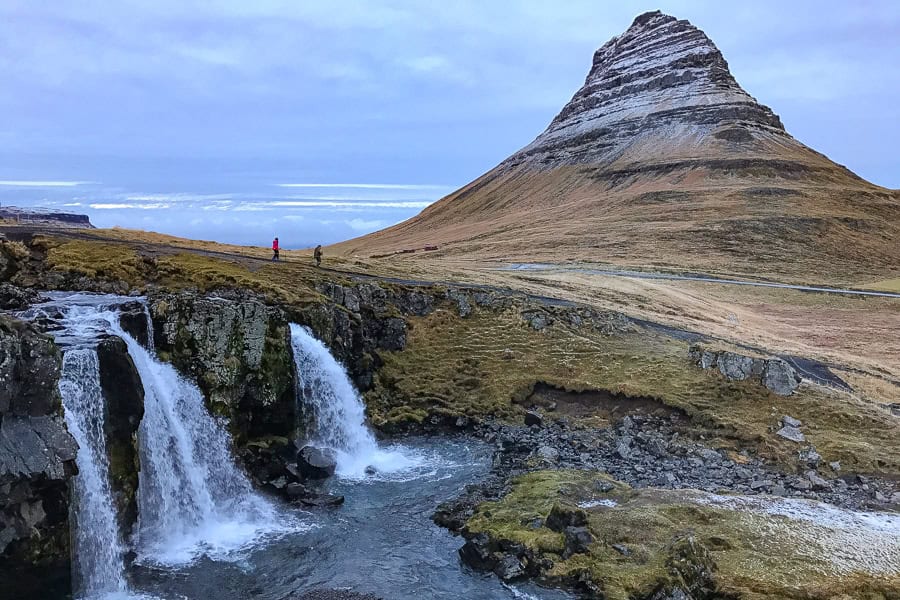
Where to Stay on the Snaefellsnes Peninsula
Sparsely populated, the Snæfellsnes Peninsula has a small, but decent choice of stays. If you want to be by the coast, Arnarstapi and Hellnar are good options, however Grundarfjördur, near Kirkjufell is probably one of the most popular spots for those looking for sunsets over the famous mountain.
We stayed at Grund í Grundarfirdi, conveniently located for Kirkjufell and just a few minutes’ drive from Grundarfjörður town. The guesthouse is in a stunning location and the hosts were friendly and helpful. Our compact room was clean and cozy, with access to a decent shared bathroom and communal kitchen and lounge.
The following other options on the peninsula also get consistently good reviews:
- Good value: Við Hafið Guesthouse – seafront location in Ólafsvík | clean modern rooms | kitchen and laundry facilities | sea and mountain views
- Mid-range: Kirkjufell Guesthouse and Apartments – clean, cozy apartments | next to Grund í Grundarfirdi | friendly staff
- Indulge: Hellnafell– speccy Kirkjufell views | fully equipped apartment | clean and cozy | fantastic host.
Day 3: Driving the Golden Circle Route
Highlights: Thingvellir National Park | Strokkur and Geysir | Gullfoss | Secret Lagoon at Flúðir
Total driving distance: appx. 330km (200 miles)
Total driving time: appx. 5 hours
Overnight: Laugarvatn
Iceland’s famous and well-touristed Golden Circle can be a shock to the system after the isolated roads of Snaefellsnes. Even so, the four major highlights along this popular route are worth mingling with the crowds for.
Aim to depart Grundarfjördur early to make the best of the day. The first point on the Golden Circle is around 190km and 2.5 hours away.
Where Plates Collide, Springs Erupt & Water Crashes
Our first stop on the Golden Circle route is the black cliffs of Thingvellir National Park. If you’re thinking it’s reminiscent of the pass to the Eyrie in Game of Thrones, it’s no coincidence: scenes from the series were filmed here in the remarkable fissures created by the meeting of the North American and Eurasian tectonic plates.
History buffs will be keen to know that Thingvellir was the site of Iceland’s – and the world’s – first parliament in the early 10th-century. It also has a more sinister past, with witchcraft burnings and drownings once carried out here.
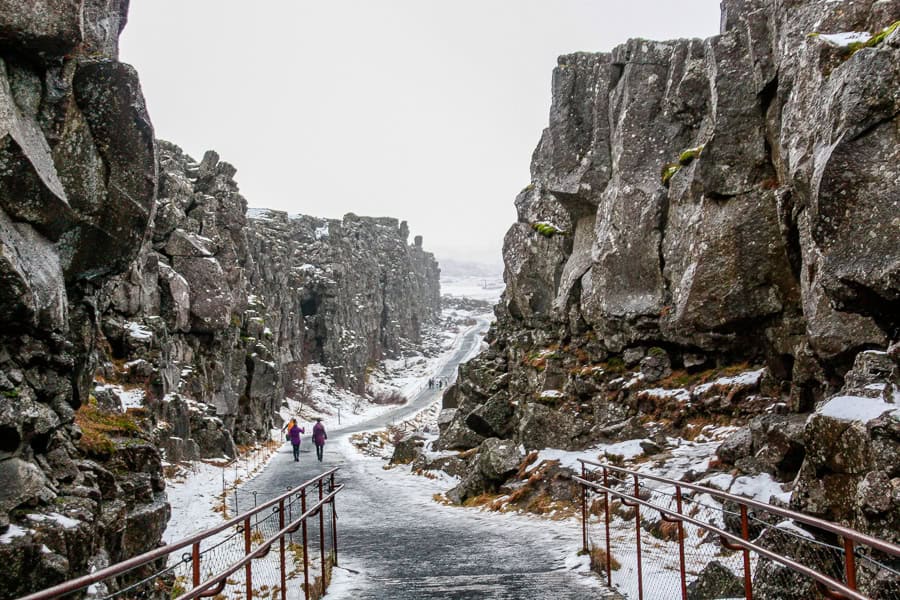
Snorkel or Dive Between Continents
For those with more time, and a penchant for chilly thrills, the national park also offers the unique opportunity to snorkel or dive between the two continents at Silfra fissure.
A freshwater dry suit dive, Silfra is said to offer the clearest water in the world, with visibility in excess of a hundred metres.
The extremely popular Diving Between Tectonic Plates tour takes small groups into the chilly depths of Silfra with a qualified PADI instructor. The photos and videos we’ve seen of this experience are nothing short of amazing, and with fantastic reviews, this is definitely on our bucket list for next time!
If you aren’t qualified to dive, the same company also offers a Snorkeling Between Tectonic Plates tour, which is also extremely popular and gets rave reviews. Free cancellation and secure booking are standard for both tours.
Waterfalls and Geysers on the Golden Circle Route
It’s about an hour from Thingvellir National Park to our first waterfall of the day. If, like us, you’re staying in Laugarvatn, you can probably drop your bags into tonight’s accommodation en route.
Iceland’s bluest waterfall, Brúarfoss can be visited from the new (paid) car park a short walk from the falls or, if you’re feeling energetic, via the Brúará Trail, a 7km return walk that starts near Route 37.
Around 20 minutes further along the Golden Circle route are the famous thermal geysers Strokkur and Geysir (this is the explosive spring that gave its name to all others of its kind).
While Geysir no longer performs for visitors, Strokkur still puts on a show, building pressure and excitement before sending up a decent spray of hot water every five to ten minutes.
Around half-an-hour from the geysers is Gullfoss, Iceland’s most famous waterfall. Cascading in stages over a broad, curved series of cliffs before thundering over a final drop, the 32-metre-high falls – which often freeze in beautiful curtains of ice in winter – is the absolute highlight of driving the Golden Circle.
So is the traditional Icelandic lamb soup on offer at the visitor centre, a good spot to thaw out afterwards and enjoy lunch.
Travel tip: If you’re visiting in winter, take care on the icy paths around Gullfoss, it gets seriously slippery!
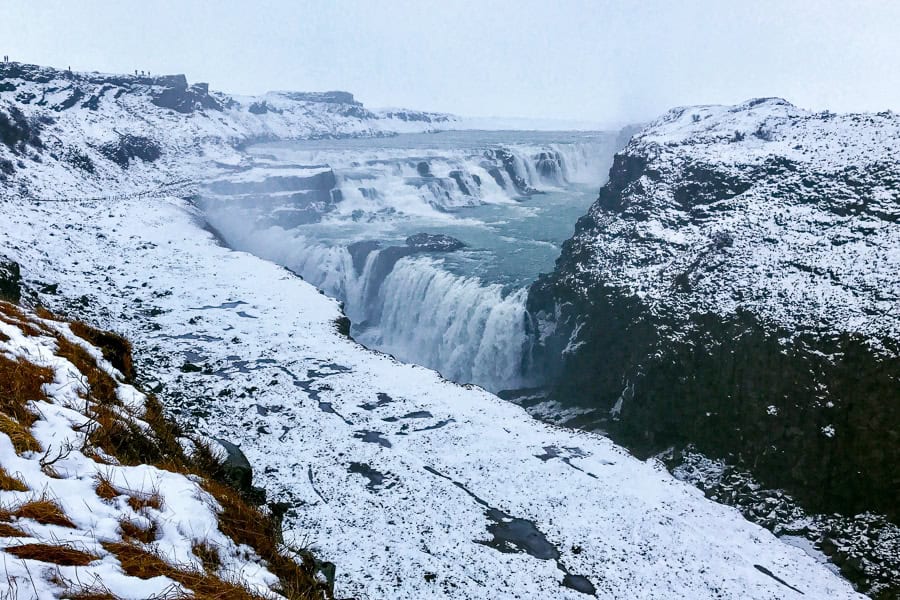
Soak Like a Local Under the Stars
If you can muster the energy at the end of your day driving the Golden Circle, we highly recommend seeking out the Secret Lagoon at Flúðir, around half-an-hour from Laugarvatn.
We were tipped off to this local hot spring by an Icelandic friend, and while it’s certainly been discovered by tourists, it’s far more authentic than the Blue Lagoon and a great place to soak away your stresses while you watch the sky for aurora.
Where to Stay on the Golden Circle
There’s a decent range of stays on the Golden Circle route, ranging from camping and hostels to farm stays, guesthouses, rustic cabins, private cottages and hotels.
Since this is Iceland’s busiest tourist trail, it’s advisable to book accommodation well in advance of your stay, especially in peak season. The following options get consistently good reviews:
- Good value: Bjork Guesthouse – clean modern rooms | private bathrooms | helpful staff
- Mid-range: Blue Hotel Fagrilundur – easy self check-in | comfortable, modern rooms | close to local eateries | relaxing hot tub | free parking
- Indulge: Hotel Geysir – stylish, comfortable rooms | nice restaurant and bar | tasty breakfast | great location next to thermal geysers | free parking.
We stayed at Héradsskólinn Historic Guesthouse, set on a picturesque lakeside spot in Laugarvatn; a perfect base for exploring Golden Circle attractions. Rooms were clean and cosy, staff were friendly and professional, and there’s a nice bar and restaurant if you want to have dinner here.
Day 4: Explore the Volcanic Landscape of Southern Iceland
Highlights: Kerid Crater | Merkjárfoss | Dyrhólaey Lighthouse and Arch | Reynisfjara Beach
Total driving distance: appx. 250km (155 miles)
Total driving time: appx. 4 hours
Overnight: Skógar
Day four of our Iceland road trip takes you down to explore the many highlights of the southern section of the Ring Road.
Before that though, there’s still time for one final stop on the Golden Circle with a visit to the striking volcanic caldera at Kerid Crater. There’s a small fee to visit this privately-owned site, where you can walk around the rim or head down the rocky red slopes to the edge of the spectacular crater lake.
After the crater, head south until you reach the southern Ring Road, then turn left towards Vik. If you drive straight to Vik, it’s a drive of just over 140km and almost 2 hours, but you’ll be stopping, side-tracking, and looping quite a bit today.
From our experience, we can assure you that the spectacular scenery along the Ring Road in southern Iceland will have you clocking up the drive time as you find yourself pulling over constantly for pics.
If you need a driving break, about an hour from Laugarvatn you’ll reach the town of Hella. Just near here, along Route 266 off to the right, you’ll find the pretty medieval church of Oddi.
Alternatively (or in addition to), take a quick detour at Hvolsvöllur along Route 261 to see Merkjárfoss. Often referred to as Gluggafoss, which translates to ‘window waterfall’, the soft rock here is full of tunnels and windows carved over millennia by the rushing water. It’s less visited than some of its famous neighbours, but that’s one of the things we liked about it.
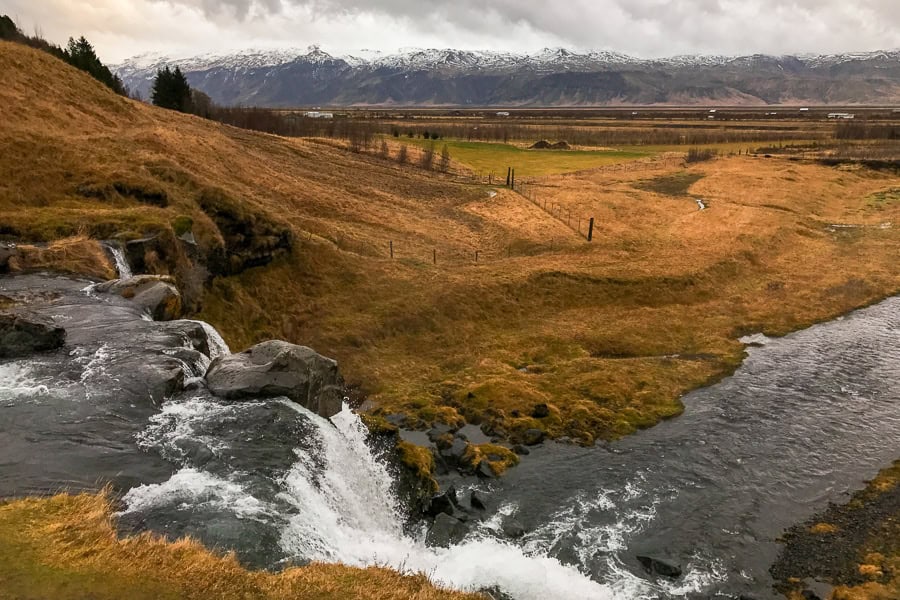
After rejoining the Ring Road and heading towards Vik, the landscape becomes even more dramatic, with the Dyrhólaey promontory dominating the landscape.
Take the narrow, bumpy trail up the peninsula to its lighthouse for sweeping views along the volcanic, black-sand coastline and the vast Dyrhólaey Arch.
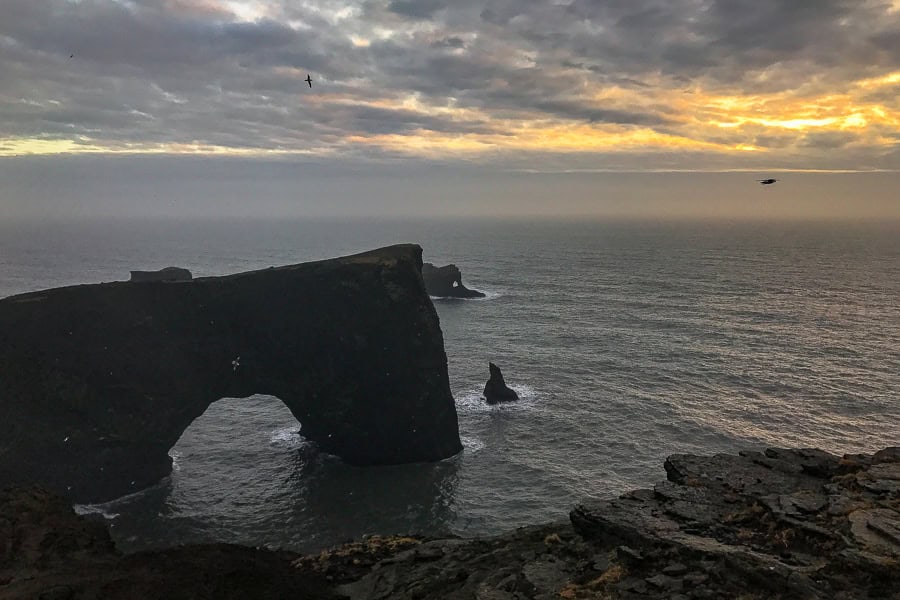
2-3 paragraphs outlining key highlights of the day.
Drive another fifteen minutes or so east and you’ll reach the moody black pebble beach of Reynisfjara, with its brooding basalt pillars offshore and spellbinding sea caves.
As the light begins to fade, the dark pebbles and angry waves of this treacherous beach make for a powerfully ambient place to end the day. In summer, this is also a great area to catch some puffin action.
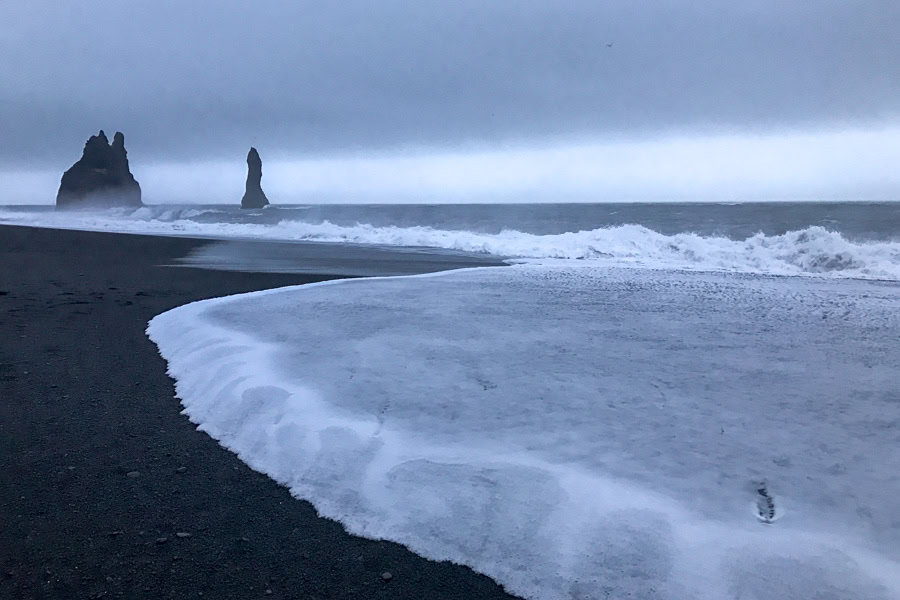
Head into Vik for dinner, and then, before heading to your chosen hotel, swing by the hilltop Vik i Myrdal Church; it’s lit up beautifully after dark.
Where to Stay on the Southern Ring Road
There’s a reasonable smattering of accommodation all along the southern Ring Road, between Selfoss in the west and Höfn in the east. Expect the usual mix of camping, hostels, guesthouses, cabins, farm stays and hotels.
Hvolsvöllur and Hella are good bases for exploring waterfalls like Seljalandsfoss and the Golden Circle, while Skógar and Vík are popular central options near Reynisfjara and Dyrhólaey. Further east, Höfn is a good choice if you want to spend time visiting Jökulsárlón and Vatnajökull National Park.
We opted to stay at Hótel Skógafoss in Skógar as we wanted to have a central base for three nights during the southern section of our Iceland road trip, without having to move accommodation every day. While this meant a little more driving on our part, we felt it was worth it to have a base for a few days.
Our room was compact and very well appointed, breakfast was plentiful, the restaurant served decent food and the staff were professional. The best part though was being able to walk across to Skógafoss waterfall whenever we wanted.
Other options along the southern Ring Road that get decent reviews include:
- Good value: The Barn – spacious clean rooms | lounge and bar | kitchen facilities | good location close to Vik
- Mid-range: Fosshotel Glacier Lagoon – modern hotel | clean, cosy rooms | close to Jökulsárlón glacier lagoon | nice bar and restaurant
- Indulge: Hótel Jökulsárlón – Glacier Lagoon Hotel – glacier views | stylish design | spacious, comfy rooms | welcoming staff | hot tub and sauna.
Day 5: More Highlights of the Southern Ring Road
Highlights: Skógafoss | Snowmobile Tour of Myrdalsjökull Glacier | Sólheimasandur Airplane Wreck
Total driving distance: appx. 30km (20 miles)
Total driving time: appx. 30 minutes
Overnight: Skógar
Feel the Spray of a Thundering Waterfall
Iceland is a country of mountains and glaciers, so it’s no surprise to see waterfalls everywhere.
From light trickles to thundering cascades, falls are a constant companion to any Iceland road trip. You’ll find yourself stopping often to admire, clamber around, and feel the spray of these wonderful natural water features.
Day 5 of our 7 day itinerary for Iceland starts with an early trip to one of these highlights of Iceland, the 25-metre-wide, 60-metre-drop at Skógafoss, a truly impressive sight. If you’re staying nearby, you’ll have the added bonus of getting here before the day-tripping crowds arrive.
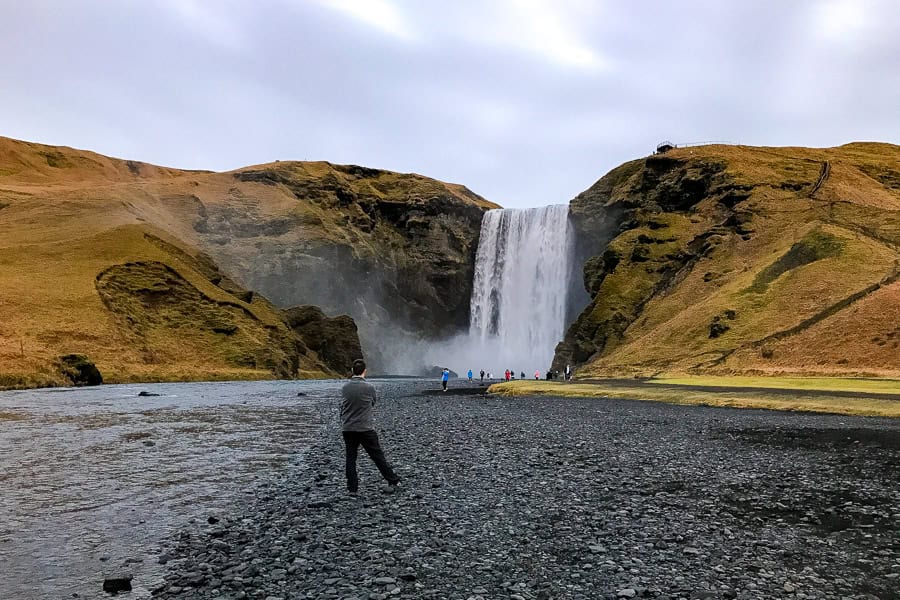
There are a couple of other waterfalls worth exploring in the area, but we’ll hold onto these for the trip back to Reykjavik, to allow more time for the next adventure: a close encounter of the volcanic kind.
Take a Spin Over a Glacier on a Snowmobile
After experiencing the chilly dawn spray of Skógafoss, it’s time to leave the crowds behind and get your Icelandic Stig on: don a boilersuit and a helmet and feel the thrill as you fly up the Myrdalsjökull Glacier aboard a snowmobile.
We joined Arcanum Glacier Tours for our adventure; trips depart from their HQ, 20-minutes west of Vik. You can book tours in advance here.
The Myrdalsjökull ice cap sits above Katla, one of Iceland’s biggest active volcanoes, a thrill in itself.
The views over the island’s south are spectacular from atop the glacier. Or so we’re told. The day we went up, the conditions were blizzard-like and there was a near-total white-out. It was an exhilarating ride nonetheless, but a soggy reminder that there’s nothing constant about the weather in Iceland.
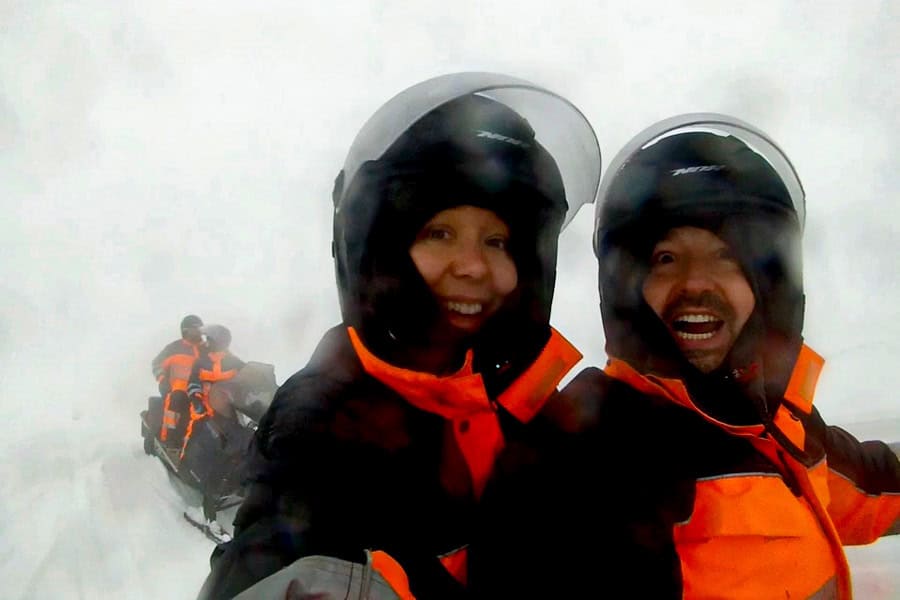
Read more about our adventure snowmobiling on a volcano in Iceland.
Depending on when you visit and how you’re going for daylight, it’s also worth considering the 8km round-trip walk across black sands out to the Sólheimasandur Airplane Wreck on the way back to Skógar (the off-road parking for the walk is almost opposite the turn off to Arcanum).
While we didn’t have a chance to do this during our trip, this is one of Iceland’s quintessential sights, and definitely looks worth the effort. There’s a shuttle bus that runs out to the wreck if you’d prefer not to walk.
There’s also an ATV tour that includes a visit to the wreck that actually departs from the same place as your snowmobile adventure.
Head back into Vik for dinner, or chill back at the hotel restaurant tonight, but don’t forget to keep your eyes peeled for aurora if you’re here at the right time of year.
Day 6: Jökulsárlón Glacier Lagoon and Ice Cave Adventures
Highlights: Jökulsárlón Glacier Lagoon | Ice Cave Tour
Total driving distance: appx. 450km (280 miles)
Total driving time: appx. 5 hours 45 min
Overnight: Skógar
Experience an Otherworldly Iceberg Lake
Jökulsárlón Glacier Lagoon is an absolute must for any Iceland road trip itinerary. It’s a drive of around 200km and 2.5 hours to the east of Vik, so hit the road early to make the most of your visit.
This haunting glacier lake is fed by the meltwaters of the Breiðamerkurjökull Glacier. Great chunks of ice break off the retreating glacier, floating in the lagoon for years before making their way to the sea.
Aside from the viewpoints around the main lagoon car park, it’s worth taking the time to visit some of the other vantage points around the lake and walk the ice-strewn shore. Keep an eye out for curious seals dodging between the bergs in the freezing waters.
At the visitor centre near the lagoon, you can book onto a boat tour of the lake itself during the warmer months (book ahead if travelling in peak).
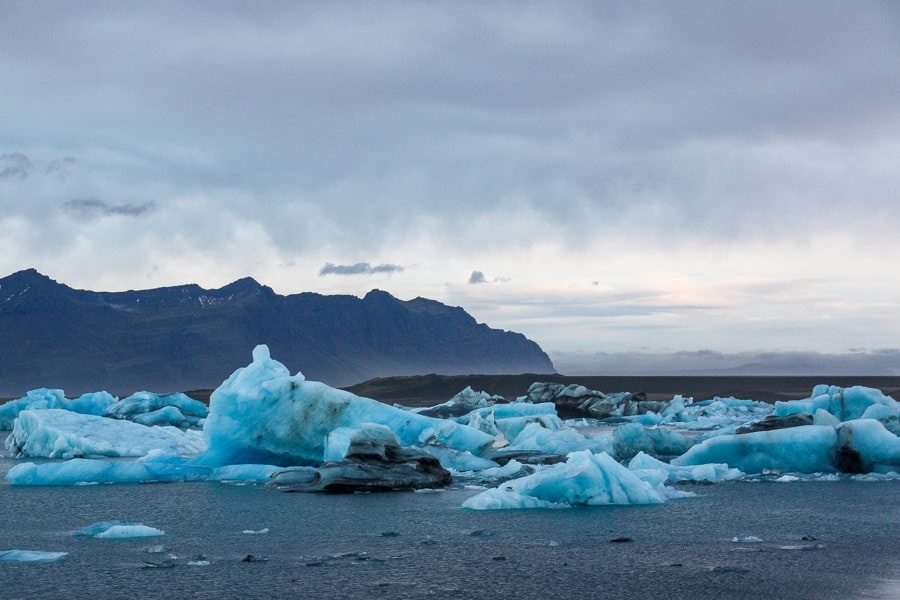
Winter Travel Tip: Given the time and distances involved in visiting Jökulsárlón, and the short daylight hours in winter, consider spending a night in this area to enjoy more time exploring the lagoon.
In summer, a day-trip is a possibility given the long hours of light, but note that it’s still a one-way trip of around five hours from Reykjavik, in good conditions.
Explore the Surreal Interior of an Ice Cave
Not far from Jökulsárlón Glacier Lagoon, another arm of the vast Jökulsárlón Glacier reaches down towards the sea and in winter, a very special phenomenon takes place: ice caves form at its terminus.
For us, strapping on crampons, hiking up a glacier and then descending into the brilliant blue expanse of the Waterfall Ice Cave proved an absolute highlight of our travels in Iceland. You can read more about our experience in our Exploring A Magical Ice Cave In Iceland post.
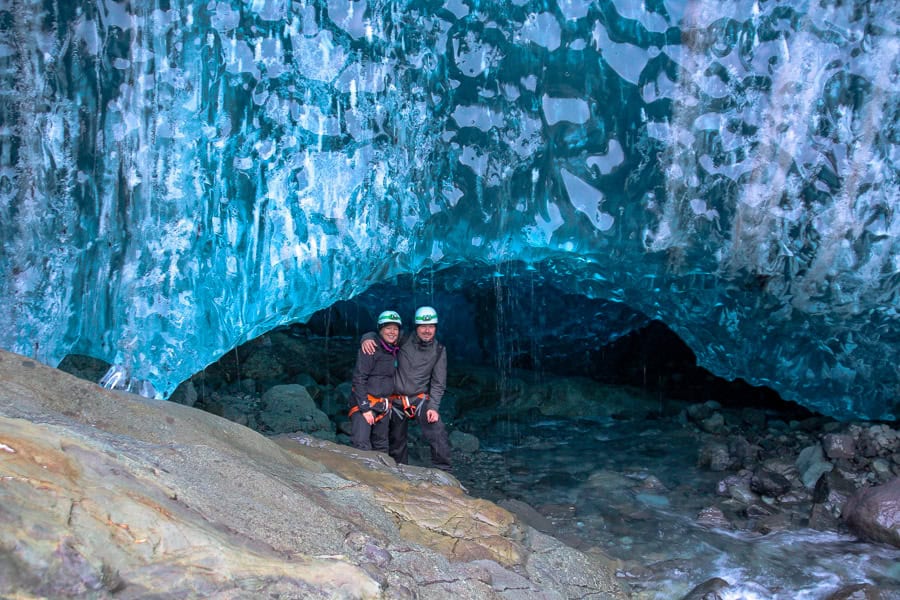
Ice cave tours depart from the Jökulsárlón car park, so it’s worth combining a visit to the glacier lagoon with an ice cave tour, a magical experience.
There are plenty of operators running ice cave tours in the area, but the popular excursions below all stand out from the crowd with excellent reviews from past customers.
Day 7: Slow Drive Back to Reykjavík
Highlights: Seljalandsfoss | The Lava Centre | Raufarhólshellir Lava Tube | Blue Lagoon
Total driving distance: appx. 240km (150 miles)
Total driving time: appx. 3.5 hours
Overnight: Keflavík (if not flying home)
Today, we’re making our way back to Reykjavík, a journey of around 240km and between 3 and 4 hours driving, with several stops along the way.
Freshen Up Behind a Cascade
Leaving the hotel in Skógar, head 20 minutes along the Ring Road back towards Reykjavík, until you reach the turn off for the picturesque falls at Seljalandsfoss and Gljúfurárbui, which cut through the high cliffs off to the right.
You can get up close to both of these epic waterfalls, and even walk behind the great cascade at Seljalandsfoss. Just be ready for a total drenching.
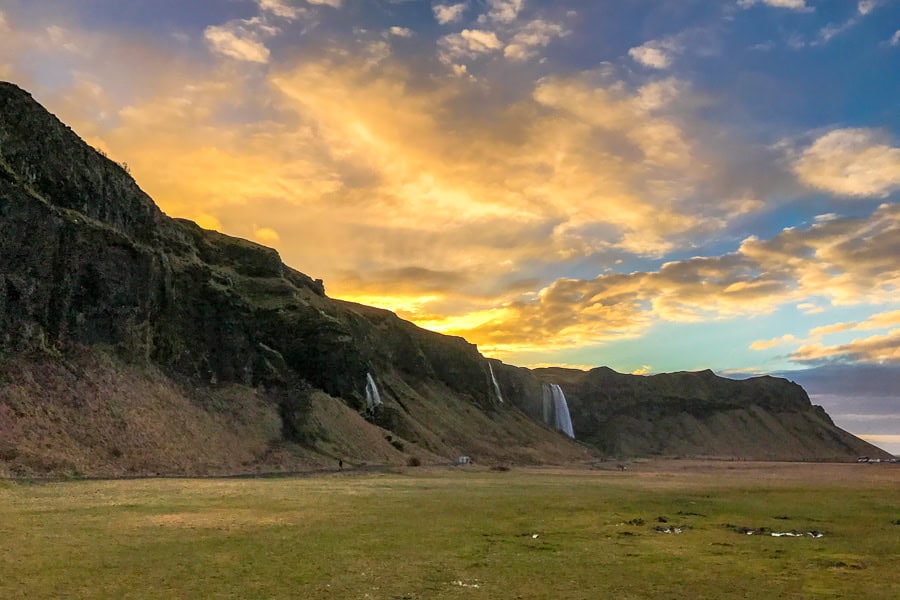
Discover the Forces Beneath Your Feet
Iceland’s geology is constantly in your face as you travel through this dramatic country, and learning about the violent forces that have created it – and which are still shaping the landscape today – adds a fascinating layer to a visit.
You’ll find the The Lava Centre 20 minutes from Seljalandsfoss in Hvolsvöllur. It’s a modern, interactive, high-tech exhibition on all things related to Icelandic volcanoes and earthquakes.

As you head back towards Reykjavik, keep an eye out on the Ring Road for Thorvaldseyri Farm. It sits at the foot of famous Eyjafjallajökull volcano, and was on the front line of the major 2010 eruption. An information panel on the side of the road tells the story.
Explore a Lava Tube
Armed with a new-found understanding of Iceland’s unique geology, why not break up the journey back to Reykjavík with a short detour to Raufarhólshellir to visit one of Iceland’s longest lava tubes.
Formed more than five thousand years ago during the Leitahraun eruption, this 1,360 metre long tunnel can be visited on guided tours that operate hourly. As always, it’s advisable to book in advance if you can.
Enjoy a Soak in the Blue Lagoon After Dark
From Raufarhólshellir, make your way back to Reykjavík and check in to your hotel. If you aren’t flying today, you have the choice of staying in the city and exploring some more, or staying on the Reykjanes peninsula.
We opted to spend our last night in Keflavik as it was closer to the airport and not far from Iceland’s world famous Blue Lagoon.
Many people end their stay in Iceland with a visit to the Blue Lagoon en route to the airport. As we had a night to spare, we decided to enjoy this particular highlight after dark.
A large geothermally-heated pool cut into the middle of a vast lava field, the Blue Lagoon is a slick operation, hugely popular and budget-biting, but very memorable.
While the milky blue waters are a sight by day, at night the Lagoon is incredibly atmospheric, with steam rising over inky water and – if you’re lucky – a clear sky full of stars, maybe even a shimmering aurora while you soak.
Smear your face with (free) silica mud, buy a drink from the swim-up bar, find a quiet corner to take in the scene, and let the warm, mineral-rich waters soothe your muscles.
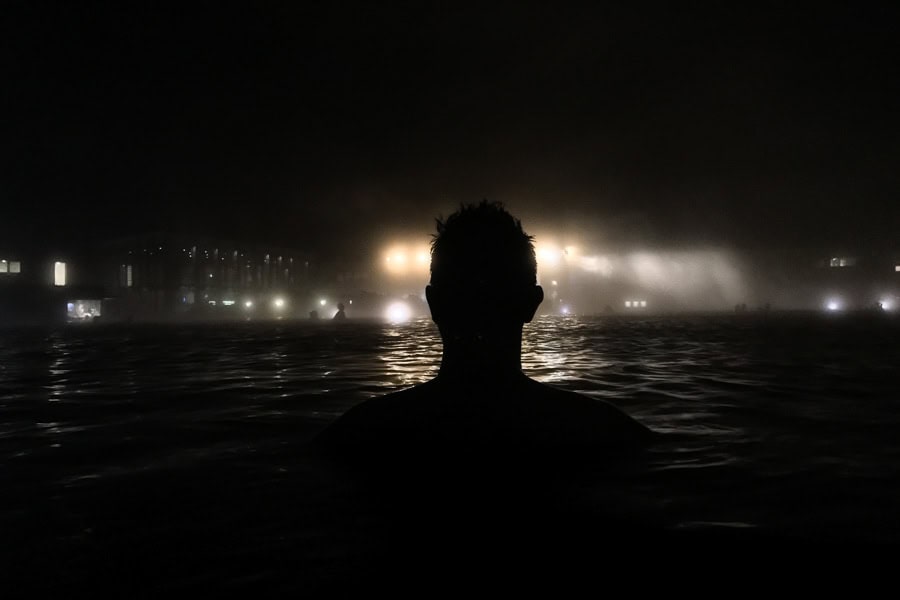
Where to Stay Around Keflavík
There are plenty of rooms to be had within a short drive from the airport at Keflavík, making this a convenient area for late arrivals or early departures.
The area is also close to the Blue Lagoon, and if you have more time, explorations of the Reykjanes Peninsula. The following options get consistently good reviews:
- Good value: Sól – S12 guesthouse – clean, cosy room | friendly host | very close to airport
- Good value: Start Keflavík Airport – super friendly staff | clean rooms | comfy beds | excellent breakfast | free parking
- Mid-range: Courtyard by Marriott Reykjavik Keflavik Airport – modern spacious rooms | bar and restaurant | free parking | free airport shuttle.
Start Planning Your Next Visit to Iceland
As our plane climbed above the clouds over Iceland, we were both lost in thought, processing the memories of our journey through this epic land of fire and ice. We loved every moment, but our one week in Iceland really just whetted our appetite for more.
We found an island rich in saga history, shaped by the harsh northern environment; a place with fierce, welcoming people who are proud of their land, and pragmatic enough to accept the unpredictable nature of the volatile environment.
While we didn’t manage to see the aurora, and the weather required a solid level of flexibility in our plans, this will always remain one of our favourite road trips for the sheer scale and raw beauty of this rugged, windswept island.
With so much more to see, the northern lights still on the bucket list, and the midnight sun to experience, there’s no doubt we’ll be back.
We hope after tasting the magic of this northern isle with our one week Iceland itinerary, you will too.
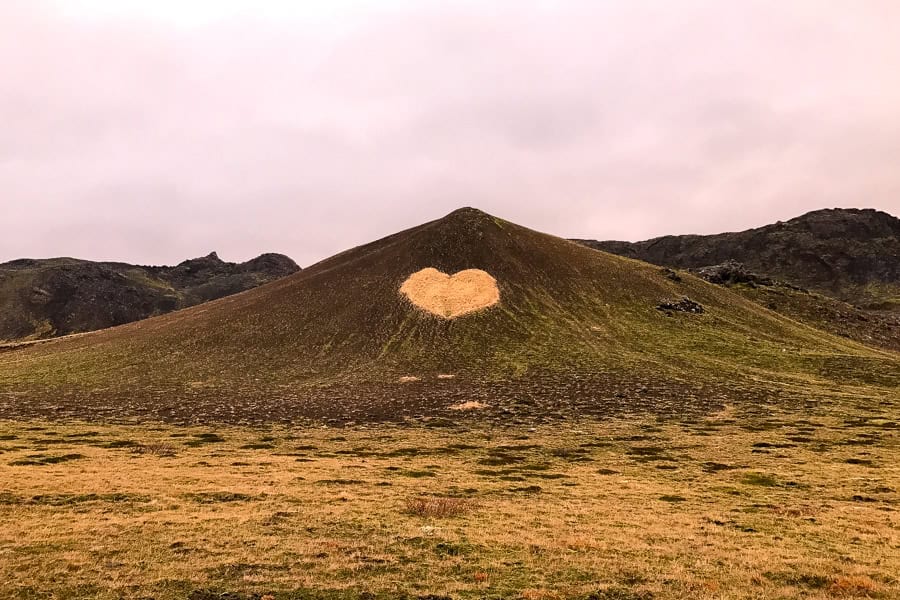
Sound like your kind of adventure? If you’ve got any questions about this 7 day itinerary for Iceland, or driving in Iceland ask us in the comments below.
If you’re looking for more great road tripping itineraries and adventures, check out our Road Trips page, and our bucket list of 100 ultimate road trips around the world.
